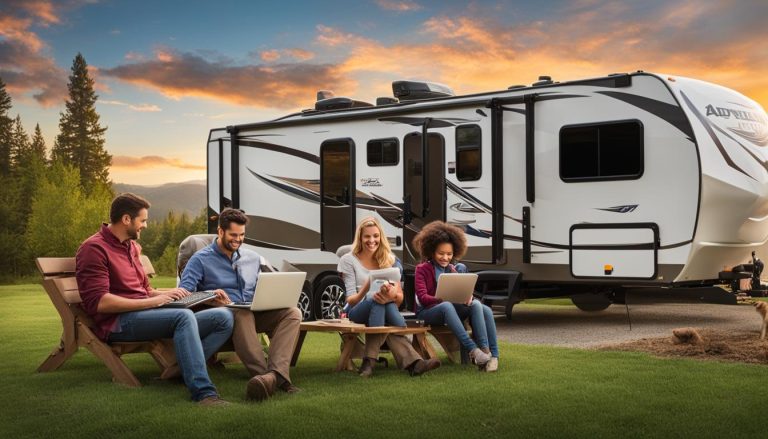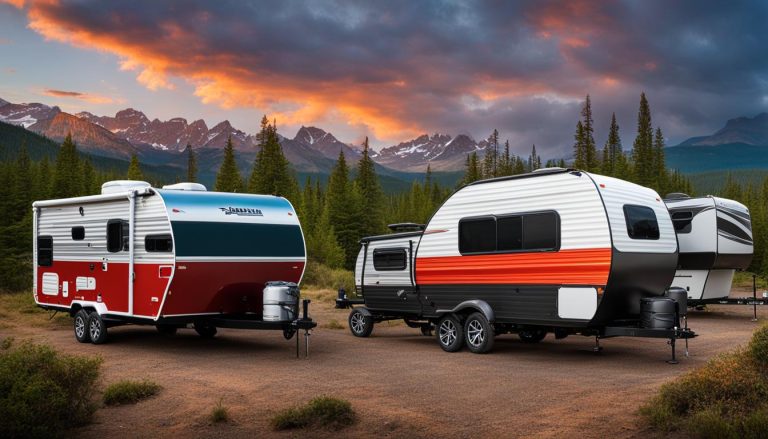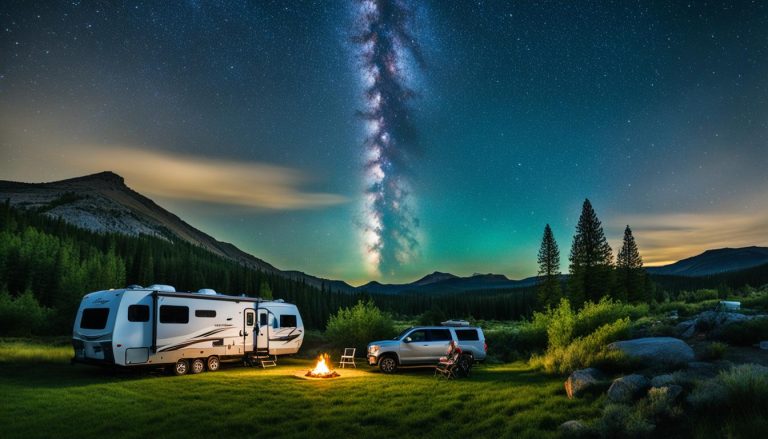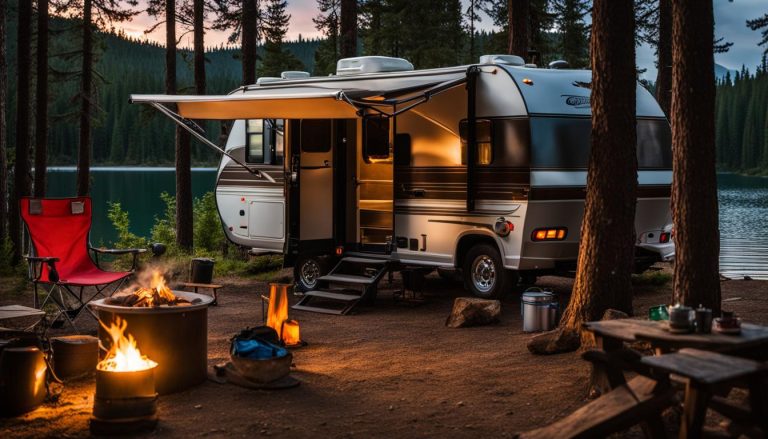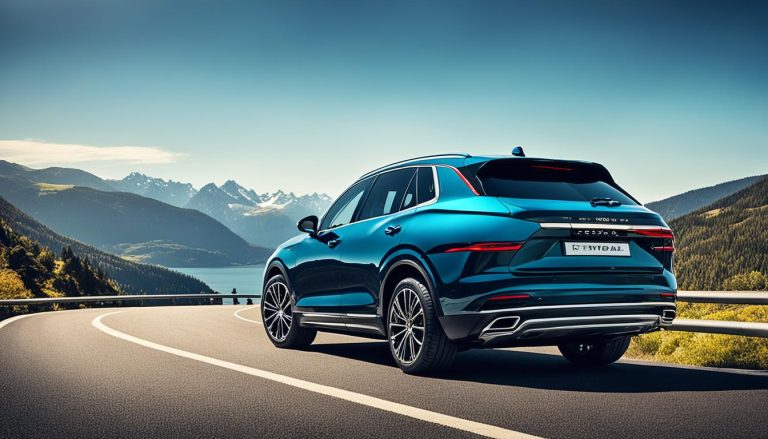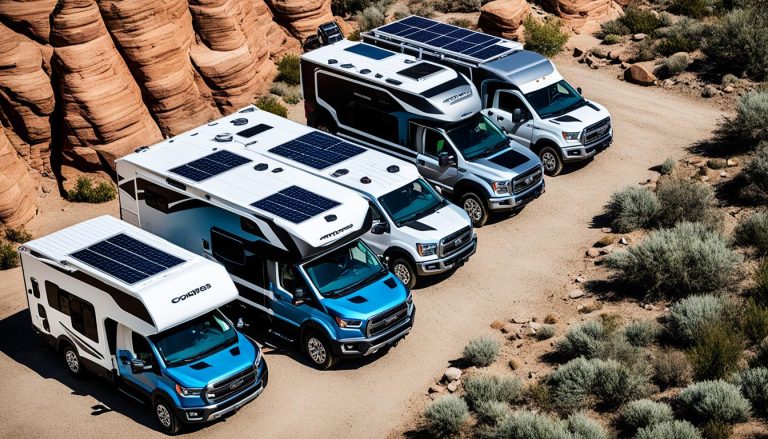Essential Pre-Purchase Inspection Tips for Towable RVs
gorvlifestyle.com and its partners may earn a commission if you purchase a product through one of our links
Purchasing a towable RV is an exciting venture filled with the promise of adventure and the comfort of a home on wheels. However, it’s an investment that calls for diligent scrutiny. For road wanderers embarking on the journey to ownership, understanding Pre-Purchase Inspection Tips when buying Towable RVs is crucial. Veteran RVers and novices alike should come equipped with an exhaustive RV inspection checklist to uncover any hidden issues that might impede their open-road dreams.
When it comes to buying a towable RV guide, there are no shortcuts. Every potential buyer must conduct essential RV pre-purchase checks to safeguard against unexpected repairs and costs. By adhering to a thorough inspection regime, you can ensure that your mobile retreat is both comfortable and reliable for your future travels.
Key Takeaways
- A comprehensive pre-purchase inspection can prevent costly future repairs.
- An RV inspection checklist ensures no detail goes unnoticed.
- Knowing essential checks can help negotiate better terms or decide when to walk away.
- Inspecting towable RVs is critical for assessing their true condition and road-worthiness.
- Investing time in learning about pre-purchase inspection can save money and provide peace of mind in the long term.
Understand the Different Types of Towable RVs
When setting out to purchase a pre-owned towable RV, being informed about the various types available is crucial. Each model offers different features and capabilities, which can significantly impact your travel experience and towing requirements. Understanding these distinctions will greatly assist in determining which used towable RV aligns with your needs.
Travel Trailers and Fifth-Wheel Trailers
Among the assortment of towable RVs, travel trailers and fifth-wheel trailers stand out for their popularity and distinct towing specifics. Travel trailers provide flexibility as they can be towed by a wide range of vehicles, from full-sized pickup trucks to some SUVs and minivans. This versatility makes them an excellent choice for those who desire ease of maneuverability and a broad selection of towing options. On the other hand, fifth-wheel trailers offer enhanced stability and extensive living space, meriting their requirement for more powerful, heavy-duty trucks due to their unique over-the-bed hitching system.
When considering what to look for in a used towable RV, inspecting the structural condition, understanding past usage and ensuring it meets weight and size specifications that correspond with your towing vehicle are all indispensable factors to take into account.
Knowing Your Tow Vehicle’s Capabilities
To maintain a safe towing experience and avoid undue strain on your vehicle, verifying tow vehicle compatibility is an essential step when selecting a towable RV. It is important to evaluate your current vehicle’s towing capacity and ensure that it exceeds the gross weight of the trailer when fully loaded. Not only does this safeguard your vehicle’s performance, but it also upholds legal towing regulations.
Remember that mismatching your tow vehicle’s capabilities with your RV can lead to increased depreciation, safety hazards, and even legal penalties.
Appropriate vehicle-RV pairing is as pivotal as the RV’s features and condition in creating a smooth and stress-free travel experience. So, delve into the owner’s manual, affirm with your dealer, or consult the manufacturer to determine the specific towing capacity and related requirements of your vehicle.
For a quick reference, here’s a comparison of typical tow vehicle classes and the RVs they can usually handle:
| Tow Vehicle Type | Travel Trailers | Fifth-Wheel Trailers |
|---|---|---|
| Standard Pickup Trucks | Yes | No |
| Heavy-Duty Pickup Trucks | Yes | Yes |
| SUVs | Mid-size to larger models | No |
| Minivans | Smaller models | No |
This table highlights some general compatibilities, but always confirm the specific towing ratings for your particular model before making a decision.
By thoroughly investigating what to look for in a used towable RV, including travel trailers and fifth-wheel trailers, and assessing tow vehicle compatibility, you can make an informed decision that will cater to your journey ahead, ensuring countless memorable adventures.
Pre-Purchase Inspection Tips when buying Towable RVs
Embarking on the journey to buy a towable RV involves more than just picking out the perfect model for your road trips. It demands a meticulous inspection to ensure the safety, functionality, and overall value of your potential home-on-wheels. Paying close attention to the following areas will arm you with crucial insights into the RV’s condition.
Assessing Structural Integrity
One of the first steps in evaluating a towable trailer is to thoroughly assess its structural integrity. This means checking the RV’s body for signs of damage, examining paint and seal conditions, and detecting rust. Inspect the main body, roof, sidewalls, and undercarriage with an eye for any abnormalities that could indicate underlying issues.
Checking Essential Systems: Plumbing, Electrical, and Propane
Towable RV’s essential systems, such as plumbing, electrical, and propane, are the lifelines that contribute to the convenience and safety of your travels. Confirm that the plumbing shows no leaks and has proper drainage, test all electrical systems from lighting to outlets, and ensure the propane systems are leak-free and operational.
Evaluating Appliances and Slide-Outs
Lastly, a crucial part of any towable RV examination is the testing of RV appliances and slide-outs. These features greatly impact daily life on the road, so they should operate smoothly and efficiently. Use diagnostic tools where available, to ensure each appliance is functioning at full capacity.
| Inspection Category | Details to Examine | Tools for Inspection | Potential Issues to Identify |
|---|---|---|---|
| Structural | Walls, roof, joints, windows | Visual inspection, moisture meter | Sealant cracks, rust, water damage |
| Plumbing | Pipes, faucets, tanks | Pressure tests, leak detection | Leaky pipes, poor drainage |
| Electrical | Outlets, wiring, battery | Circuit testers, voltmeter | Overloaded circuits, dead battery |
| Propane | Hoses, tanks, connectors | Gas sniffer, soapy water test | Leaks, corrosion, expired tanks |
| Appliances | Heater, AC, refrigerator | Thermometer, operational tests | Inefficient cooling/heating, noise |
| Slide-Outs | Mechanics, seals, motor | Mechanical inspection, seal inspection | Jammed slides, worn seals |
Performing a Visual Examination of the Exterior
Thoroughly inspecting the exterior of a towable RV provides crucial insights into its overall condition and potential future maintenance needs. The visual examination should include a detailed look at windows, doors, and seals, along with identifying any telltale signs of water damage or rust that could compromise the RV’s integrity or lead to expensive repairs down the line.
Examining the Condition of Windows, Doors, and Seals
One of the first aspects to assess during an RV exterior inspection is the window condition in RVs. Any cracks or discoloration can indicate age or damage that may require attention, while damaged seals around windows and doors can lead to leaks and moisture build-up inside the RV. It’s essential to check the door seals in RVs meticulously as they are key components that protect the interior from various elements.
Checking for Signs of Water Damage or Rust
During the inspection process, identifying RV water damage signs is a top priority. Water stains, a musty odour, and soft flooring are all red flags that should not be ignored. Additionally, a towable RV rust inspection is vital, particularly around the undercarriage and any metal fixtures. Rust can jeopardize structural integrity and safety, indicating severe deterioration that might be costly to remedy.
| Exterior Component | Condition Checklist | Concerns to Look For |
|---|---|---|
| Windows & Seals | Check for cracks, seal integrity, and ease of operation | Cracks, fogging between panes, decayed seals |
| Doors & Locks | Inspect door frames, hinges, and locking mechanisms | Bent frames, rusted hinges, faulty locks |
| Exterior Walls | Examine for dents, scratches, and delamination | Bulging or bubbling surfaces, deep scratches |
| Tires & Wheels | Assess tread depth, signs of wear, and air pressure | Uneven tire wear, sidewall damage, insufficient inflation |
Employing a disciplined approach to your visual examination is key to ensuring the towable RV can provide safe and enjoyable travels. Pay close attention to each aspect of the exterior to guarantee a reliable investment and peace of mind during your outdoor adventures.
Inspecting the Interior for Comfort and Quality
The RV interior inspection is a critical component of assessing the overall condition and value of a towable RV. More than just an aesthetic overview, it involves a meticulous evaluation of each component inside the RV to ensure both comfort and functionality. When inspecting RV furniture and RV built-in features, it is important to consider the daily living experience within the space, as well as the longevity of the materials and constructions.
Assessing Furniture and Built-In Features
RVs are known for maximizing space with multi-functional furniture and built-ins. During an inspection, it is essential to thoroughly test all foldable and transformable parts for ease of use and stability. Checking the condition of sofas, beds, and storage spaces offers insight into the quality of the living space. Whether it is spotting interior RV wear or ensuring that everything is anchored properly, the furniture tells a story of the RV’s previous use and upkeep.
Looking for Signs of Wear and Potential Leaks
Detecting early signs of wear can prevent larger issues down the road. Inspectors should look closely at areas around windows, vents, and slide-outs, where wear is more likely to signal underlying problems such as leaks. Detecting RV leaks early can save time and resources, as they can lead to significant damage if left unaddressed. Engaging with the space gives a clear perspective on which areas may need immediate attention or repair.
| Inspection Area | Details to Examine | Signs of Wear or Damage |
|---|---|---|
| Furniture | Upholstery, structure, and convertibility | Tears, stains, broken components |
| Built-In Features | Operation of slide-outs, cabinets, and fixtures | Loose hardware, misalignment, faulty mechanisms |
| Seals and Seams | Tightness and integrity around windows and doors | Cracks, gaps, or discoloration |
| Walls and Ceilings | Cleanliness, presence of moisture, integrity of paneling | Water stains, soft spots, or bubbling |
In summary, a thorough RV interior inspection not only involves scrutinizing the aesthetics but also spotting interior RV wear and functionality issues that could impact the overall RV experience. By detecting RV leaks and checking for signs of damage, potential buyers can make informed decisions and invest with peace of mind.
How to Test Towable RV Mechanical Systems
Before embarking on any journey, it is crucial for RV owners to conduct a comprehensive test of their vehicle’s mechanical systems. Not only does this ensure road safety, it also provides peace of mind that the recreational vehicle is functioning at its optimum level. In-depth testing of the engine performance, transmission health, brake functionality, and temperature control systems can identify potential issues early, saving time and money in the long run.
Evaluating Engine, Transmission, and Brakes
Testing RV mechanical systems starts with a thorough evaluation of the engine. Check engine fluids, look for leaks, and observe the engine during startup to ensure smooth operation. Performance issues here may signify the need for deeper investigation or maintenance. Next, assess the transmission health by monitoring for smooth shifts and listening for unusual noises. Lastly, an inspection of the RV brake functionality is non-negotiable. Check brake responsiveness, pad wear, and the condition of rotors to guarantee safe stopping capability.
Analyzing the Performance of Heating and Cooling Systems
RV heating systems and cooling systems play a critical role in ensuring comfort during travel. Testing these systems under various environmental conditions helps evaluate their efficiency and reliability. Make sure heating units produce adequate warmth for colder climates, while cooling systems should offer respite from the heat. All vents should be clear, and filters replaced as necessary to enable smooth operation of heating and cooling units.
Moreover, it’s conducive to simulate living conditions within the RV to ensure all mechanical systems perform consistently. Refer to the following table for a snapshot of items to test within your RV’s mechanical spectrum:
| System | Items to Test | Expected Performance |
|---|---|---|
| Engine | Fluid levels, startups, leaks | No leaks, steady idle, clean fluids |
| Transmission | Shift smoothness, unusual sounds | Smooth transitions, no grinding noises |
| Brakes | Responsiveness, pad wear, rotor condition | Immediate response, pads with > 1/4″ thickness, unscarred rotors |
| Heating | Heat output, vent blockages, filter condition | Even heating, clear vents, clean filters |
| Cooling | Air output temperature, refrigerant levels | Cool air production, adequate refrigerant |
Essential RV Pre-Purchase Checks: Tires and Suspension
Conducting RV pre-purchase checks is a non-negotiable step for prospective RV owners. Two critical components that demand attention are the towable RV tires and the RV suspension system. For the safety and longevity of the vehicle, ensuring that both are in excellent condition before making a purchase is of utmost importance.
Inspecting the tires involves more than just a cursory glance. One should check for adequate tread life and proper inflation, measured in PSI, to match the manufacturer’s specifications. Any visible damage, such as cracks or uneven wear, may suggest potential issues that could compromise safety or performance. Similarly, the suspension demands a thorough inspection—a vigilant eye can spot telltale signs of wear or damage that might lead to bumpy rides or even hazardous travel conditions.
| Checklist Item | What to Look For | Consequence of Overlooking |
|---|---|---|
| Tire Tread Depth | Measure to ensure it is above legal requirement | Poor traction and increased stopping distances |
| Tire Pressure (PSI) | Match to RV manufacturer’s specification | Increase in tire wear, risk of blowouts |
| Tire Walls | Check for bulges, cracks, or excessive wear | Structural integrity compromised, potential for rapid deflation |
| Axles and Joints | Inspect for any signs of strain, cracking or rust | Can lead to catastrophic mechanical failure |
| Brakes and Pads | Look for wear, proper alignment, efficient response | Increased stopping distances, possible accidents |
| Suspension Components | Examine for corrosion, leakage, or weakening | Poor handling, increased wear on RV structure and components |
Without rigorous inspection of these aspects, you might confront unwelcome surprises down the road, influencing not only your comfort but, more critically, your well-being. RV suspension inspection, paired with tire checks, creates a holistic view of the RV’s readiness for the road, reassuring you of your vehicle’s road-worthiness.
A seasoned eye can often distinguish the subtleties of tire and suspension conditions—issues that might elude a first-time buyer. Remember, these checks are an investment in peace of mind and ensure the RV you choose can faithfully accompany you on many adventures.
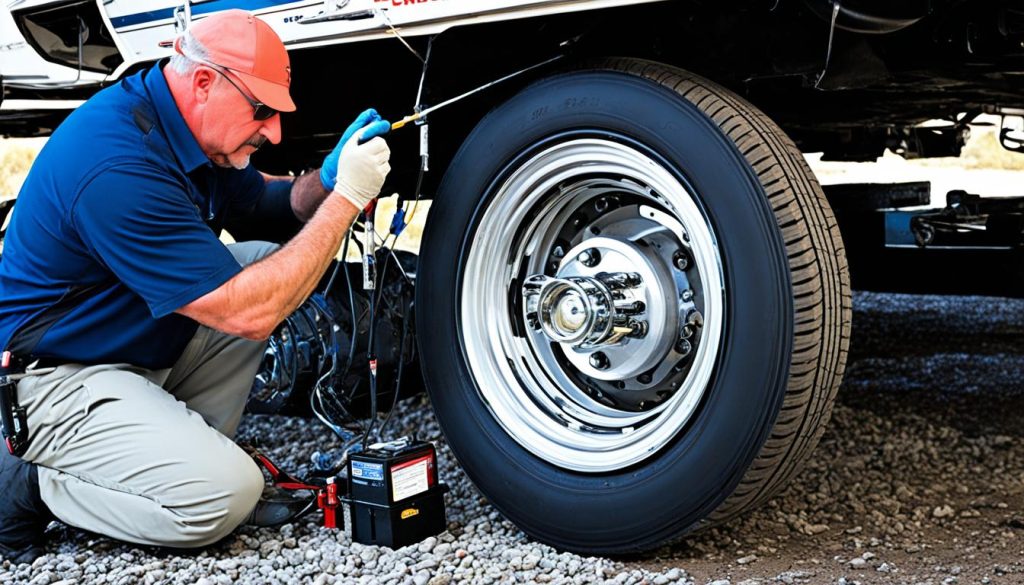
Reviewing Electrical Systems and Appliances
Ensuring the safety and functionality of RV electrical systems is a critical step in the inspection process of any towable vehicle. Properly conducted RV appliance inspection and towable RV electrical check can prevent inconvenient malfunctions and potential hazards during your travels. The key is to focus on both the power sources and the appliances that make the RV a comfortable and functional home away from home.
Rigorous testing of the RV’s electrical infrastructure demands attention to both alternating current (AC) and direct current (DC) outlets. Here, the reliability of connection points, as well as the efficacy of the RV’s power converters, is evaluated. As appliances serve as the lifeblood of the RV’s convenience offerings, they must be inspected to verify their condition and smooth operation.
| Electrical Component | Inspection Criteria | Status Indication |
|---|---|---|
| AC/DC Power Outlets | Functionality, secure fittings, no signs of wear or heating | Safe to use |
| Lighting Fixtures | Operational, no flickering or dimming unexpectedly | Good condition |
| Air Conditioning Units | Correct cold air output, responsive controls | Optimal Performance |
| Refrigeration | Stable temperature, no condensation | Fully Functional |
All lighting should operate effectively, an essential feature for both convenience and safety. Illumination checks cover both interior and exterior light sources. Special attention is given to the RV’s climate control system, with air conditioning units rigorously tested to ensure they produce a comfortable flow of cold air during warmer climates.
An RV appliance inspection doesn’t merely stop at operation checks; it requires a keen eye to identify any unusual sounds, odors, or vibrations that could signal an underlying problem. By comprehensively reviewing these elements, the longevity and efficiency of these systems can be verified, reinforcing the recreational vehicle’s road-worthiness and your peace of mind.
Remember, well-maintained RV electrical systems are not only about convenience but are integral to the overall safety of your mobile habitat. A thorough inspection mitigates risks associated with electrical faults and ensures that your adventure on the road remains uninterrupted by technical difficulties.
Navigating RV Inspection Checklists
Embarking on the journey to purchase a towable RV can be as exciting as the adventures that await, yet it requires meticulous attention to detail in the inspection process. A comprehensive RV checklist is an invaluable tool for prospective buyers, facilitating a thorough review of the vehicle’s condition and ensuring all essential aspects are assessed.
The Importance of a Comprehensive Checklist
A comprehensive RV checklist serves as the backbone of a diligent pre-purchase examination. It guarantees that from the smallest fitting to the largest appliance, each component of the RV is scrutinized and evaluated for functionality and safety. This thoroughness not only contributes to immediate peace of mind but also enhances long-term satisfaction with your investment.
Breaking Down the Inspection Process Step by Step
Approaching an RV inspection utilizing a step-by-step RV inspection framework ensures no element goes unnoticed. Let’s delve into the specifics of what such a process might look like.
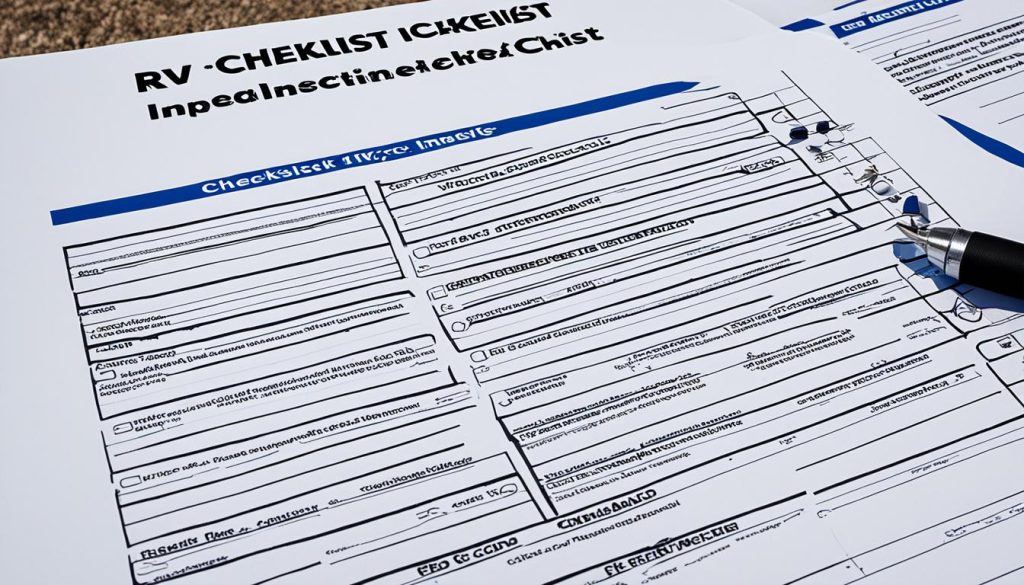
| Exterior Inspection | Interior Inspection | System Checks |
|---|---|---|
| Inspect overall body condition | Check for upholstery wear and tears | Verify operation of heating and cooling |
| Examine windows, doors, and sealant | Ensure all lights and electronics function | Test all kitchen and bathroom appliances |
| Check undercarriage for damage or rust | Search for signs of leaks or water damage | Assess battery life and electrical system |
| Evaluate tire tread and pressure | Inspect smoke and carbon monoxide detectors | Perform propane system leak test |
| Test lighting and reflectors | Review the condition of slide-outs | Check plumbing for proper drainage |
A towable RV inspection process is substantially detailed, yet with such a RV inspection checklist in hand, you can systematically evaluate each critical area. This not only streamlines the inspection process but also equips you with the information you need to make an informed decision, or to negotiate repairs or price adjustments with the seller.
Remember, whether you’re a seasoned RV enthusiast or a first-time buyer, taking the time for a methodical RV inspection will safeguard your investment and set the stage for countless happy memories on the open road.
The Significance of RV Insurance Coverage
Embarking on the journey of owning a towable RV is an exciting endeavor, but it’s important to ensure that this investment is safeguarded against potential risks. Understanding the intricacies of RV insurance coverage can help RV owners tailor policies to their specific needs, giving them peace of mind as they explore the open road.
Understanding Your Insurance Needs
Selecting the right RV insurance coverage goes beyond basic liability. Owners must consider the full range of towable RV insurance needs, which span from comprehensive coverage for theft or non-collision damage to specific protection plans for personal belongings inside the vehicle. It’s also prudent to assess the need for roadside assistance and full replacement cost coverage, especially if the RV is intended for frequent or full-time use.
Comparing Policies for Optimal Protection
Diligent RV owners will spend time comparing various RV insurance policies. This means evaluating each plan’s coverage options, deductibles, and premiums. To make an informed decision, it’s helpful to create a detailed comparison of the most respected RV protection plans available in the market. Doing so ensures that you are not only getting a competitive price but also receiving the coverage that best matches your lifestyle and the specific threats that your RV may face.
- Liability Coverage – essential for bodily injury and property damage protection
- Comprehensive Coverage – for non-collision related risks like fire, theft, or vandalism
- Uninsured/Underinsured Motorist Protection – crucial in the event of an accident with a driver who has no insurance or insufficient coverage
- Roadside Assistance – offers peace of mind for unexpected breakdowns
- Full Replacement Cost Coverage – reimburses the full cost of the RV without depreciation in the event of a total loss
Remember, investing time in finding the right insurance for your RV initially can potentially save you from significant financial losses and headaches later on. It’s the key to a carefree adventure experience in your towable home-away-from-home.
Buying a Towable RV Guide: Finalizing the Deal
Finalizing your RV purchase marks a pivotal moment in the journey of becoming an RV owner. Thoroughly negotiating the RV price and understanding the intricacies of the towable RV sales contracts are crucial steps in ensuring a fair deal and a smooth adventure on the road. An informed approach and careful deliberation can turn the anticipation of driving away with your new RV into a reality replete with confidence and excitement.
Negotiating the Price and Terms
When it’s time to take the plunge, negotiating the RV price is more than just quibbling over dollars and cents; it’s about reaching an agreement that benefits both you and the dealer. Savvy buyers recognize that the stated price is a starting point for discussion. By doing your homework, you can identify a fair price range for the RV you’re considering and use this knowledge to empower your negotiations.
What to Look for in Sales Contracts
Ensuring that each detail is meticulously documented in the towable RV sales contracts can save you from headaches down the road. This document should clearly outline not only the purchase price but also any warranties, service agreements, and the responsibilities of each party involved. A comprehensive contract is a roadmap for your ownership experience—it’s imperative to have a clear understanding of every term and clause.
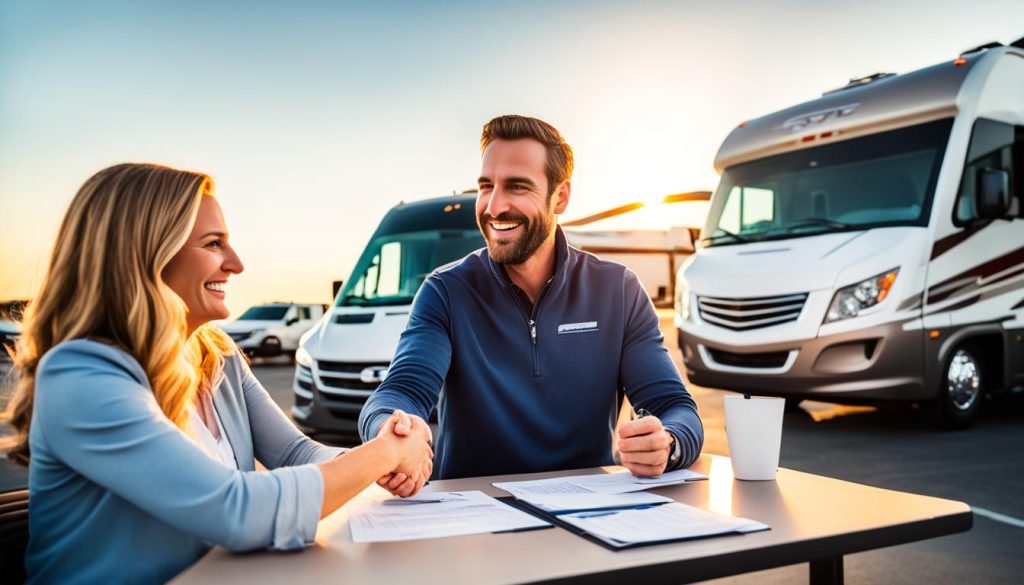
| Contract Section | What to Look For | Why It’s Important |
|---|---|---|
| Purchase Price | Negotiated price of the RV | Confirms the agreed-upon value |
| Warranties | Coverage details and duration | Defines protection for your investment |
| Responsibilities | Buyer and dealer obligations | Clarifies expectations and requirements |
| Contingencies | Conditions that must be met before the sale is final | Outlines terms that could affect the sale |
| Services Included | Pre-delivery inspections and preparations | Ensures RV is ready for immediate use |
As you prepare to embark on new adventures, remember that the process of finalizing your RV purchase is the foundation upon which countless memories will be built. Whether it’s a cozy weekend getaway or a cross-country expedition, the attention to detail during the negotiation and contract phases of purchasing your towable RV will pave the way for stress-free travels as you explore the great outdoors.
Tips for Inspecting a Towable RV: Seeking Professional Help
Buying a recreational vehicle is a substantial investment and ensuring that your potential home-on-wheels is in top condition is crucial. It’s in scenarios like this where the value of a professional RV inspection becomes clear. Relying on expert services to assess a towable RV can save abundant time and money, as well as provide a comprehensive evaluation that goes beyond the capabilities of most non-specialists.
The Benefits of Hiring a Professional RV Inspector
Hiring a professional RV inspector is not an expense but an investment into peace of mind and safety. Inspectors are trained to spot everything from subtle signs of wear to potential safety hazards. From the condition of the brakes to the structural integrity of the frame, professionals expedite the process and provide a level of scrutiny that can be vital for long-term satisfaction and security.
When to Consider a Professional Inspection
There are several situations where **hiring an RV inspector** is particularly advisable. If you lack a technical background in vehicle mechanics or the RV is in a remote location, professional help ensures you’re not buying into hidden problems. Moreover, an expert inspector’s perspective is invaluable if you’re considering an older model or a towable RV that might need significant updates or renovations.
| Consideration | Self-Inspection | Professional Inspection |
|---|---|---|
| Technical Knowledge | Limited to user’s know-how | Extensive, specialized training |
| Attention to Detail | May miss subtle signs of damage | Trained to identify hidden issues |
| Time and Convenience | Time-consuming | Efficient and thorough |
| Post-Inspection Report | Self-made and potentially incomplete | Detailed report with professional insight |
| Future Maintenance | Uncertain | Guided by expert recommendations |
In summary, whether you’re a seasoned RVer or a first-time buyer, the advantages of obtaining **towable RV professional help** for an inspection are many. Not only does it ensure that all systems are functioning as expected, but it also steers you clear of potential financial pitfalls, possibly negotiating a better deal or steering clear from a poor investment altogether.
Planning a Safe Purchase: Knowing When to Walk Away
In the journey of safe RV purchase planning, it’s vital to identify red flags that could signal a poor investment. Just as you would diligently inspect an RV for its features and amenities, so too must you be vigilant in recognizing RV deal-breakers. These critical issues, often uncovered during a thorough pre-purchase inspection, might not only result in significant financial strains but could also compromise your safety on the road.
Let’s discuss some of the key deal-breakers that should prompt any buyer to reconsider their potential RV purchase:
- Severe Water Damage: Lingering moisture or water stains can lead to mold, structural damage, and other costly repairs.
- Major Mechanical Failures: Engine problems or faulty transmission could mean your adventure is over before it begins.
- Poor Maintenance History: A poorly kept RV can lead to a domino effect of malfunctioning systems and components.
Once these critical issues are detected, it may be difficult to rectify them without incurring substantial costs. To aid in elucidating these key areas, here is a detailed table highlighting common deal-breakers and their potential impact:
| Deal-Breaker | Potential Impact | Cost Implication |
|---|---|---|
| Severe Water Damage | Structural deterioration, mold, and electrical issues | Extensive and potentially unresolvable without replacement |
| Major Mechanical Failures | Unsafe driving conditions, increased likelihood of breakdowns | High, especially if engine or transmission replacement is needed |
| Poor Maintenance Record | Unreliability and frequent need for repairs | Varies, but often indicative of deeper, unaddressed issues |
Being equipped with the knowledge to identify and act upon these RV deal-breakers is instrumental in ensuring that your vehicle purchase is not only a source of joy but also a sound financial decision. Remember, walking away from a bad deal opens the pathway to finding an RV that will provide safe and memorable journeys for years to come.
Pre-Buy Inspection for Towable RVs: Ensuring Road-Worthiness
Before committing to the purchase of a towable RV, a meticulous pre-buy inspection is fundamental to ensure road-worthiness and to safeguard your investment. This crucial step not only brings you closer to finding the perfect RV for your nomadic aspirations but also ensures a more secure and pleasant travel experience. It involves examining all components critical for a safe journey, conducting a comprehensive test drive, and assessing the suitability of the vehicle for long-term excursions. Paying attention to these factors is key to avoiding unexpected breakdowns and maintaining peace of mind while exploring the open roads.
Conducting a Test Drive
Diving into the driver’s seat for a towable RV test drive is more than just a feel of the wheel; it is an irreplaceable part of the pre-buy RV inspection process. The test drive helps you gauge the handling, stability, and overall performance of the trailer on the road. It’s essential to take note of how the RV responds to different driving conditions, such as acceleration, braking, and turning. Any odd sounds, vibrations, or handling quirks can be early indicators of potential problems, giving you leverage to negotiate or inform your decision to proceed with the purchase.
Verifying the Suitability for Long Trips
Long trip RV preparation should be on top of the checklist for adventurers looking to embark on extensive travels. Checking that every aspect of the towable RV aligns with road-worthiness standards is invaluable. Inspect the livability features, such as sleeping configurations, food storage facilities, and comfort levels during transit. Also, verifications of crucial systems like brakes, lights, and signals alongside the fluid levels, tires, and batteries are definitive steps toward assessing the towable RV’s preparedness for the long haul. It’s not just about getting from A to B; it’s about doing so without hitch after hitch interrupting the journey.

